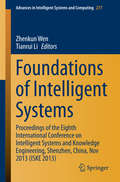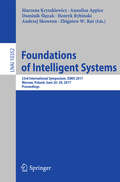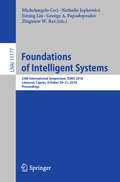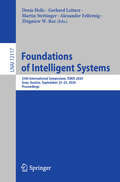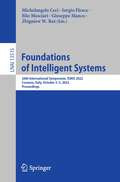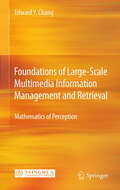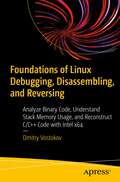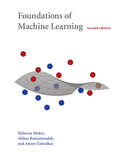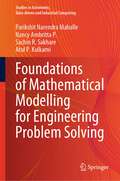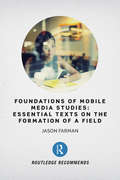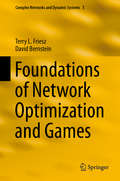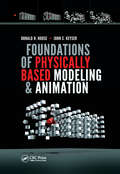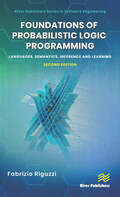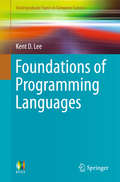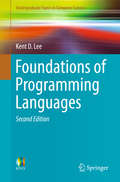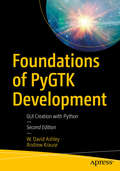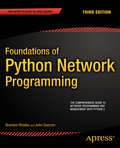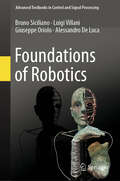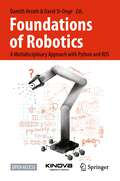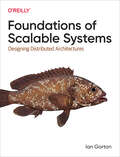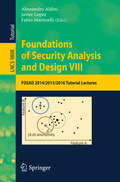- Table View
- List View
Foundations of Intelligent Systems
by Tianrui Li Zhenkun Wen"Foundations of Intelligent Systems" presents selected papers from the 2013 International Conference on Intelligent Systems and Knowledge Engineering (ISKE2013). The aim of this conference is to bring together experts from different expertise areas to discuss the state-of-the-art in Intelligent Systems and Knowledge Engineering, and to present new research results and perspectives on future development. The topics in this volume include, but not limited to: Artificial Intelligence Theories, Pattern Recognition, Intelligent System Models, Speech Recognition, Computer Vision, Multi-Agent Systems, Machine Learning, Soft Computing and Fuzzy Systems, Biological Inspired Computation, Game Theory, Cognitive Systems and Information Processing, Computational Intelligence, etc. The proceedings are benefit for both researchers and practitioners who want to utilize intelligent methods in their specific research fields. Dr. Zhenkun Wen is a Professor at the College of Computer and Software Engineering, Shenzhen University, China. Dr. Tianrui Li is a Professor at the School of Information Science and Technology, Southwest Jiaotong University, Xi'an, China.
Foundations of Intelligent Systems: 23rd International Symposium, ISMIS 2017, Warsaw, Poland, June 26-29, 2017, Proceedings (Lecture Notes in Computer Science #10352)
by Marzena Kryszkiewicz, Annalisa Appice, Dominik Ślęzak, Henryk Rybinski, Andrzej Skowron and Zbigniew W. RaśThis book constitutes the proceedings of the 23rd International Symposium on Foundations of Intelligent Systems, ISMIS 2017, held in Warsaw, Poland, in June 2017. The 56 regular and 15 short papers presented in this volume were carefully reviewed and selected from 118 submissions. The papers include both theoretical and practical aspects of machine learning, data mining methods, deep learning, bioinformatics and health informatics, intelligent information systems, knowledge-based systems, mining temporal, spatial and spatio-temporal data, text and Web mining. In addition, four special sessions were organized; namely, Special Session on Big Data Analytics and Stream Data Mining, Special Session on Granular and Soft Clustering for Data Science, Special Session on Knowledge Discovery with Formal Concept Analysis and Related Formalisms, and Special Session devoted to ISMIS 2017 Data Mining Competition on Trading Based on Recommendations, which was launched as a part of the conference.
Foundations of Intelligent Systems: 24th International Symposium, ISMIS 2018, Limassol, Cyprus, October 29–31, 2018, Proceedings (Lecture Notes in Computer Science #11177)
by Nathalie Japkowicz Michelangelo Ceci George A. Papadopoulos Jiming Liu Zbigniew W. RaśThis book constitutes the proceedings of the 24th International Symposium on Foundations of Intelligent Systems, ISMIS 2018, held in Limassol, Cyprus, in October 2018. The 32 full, 8 short, and 4 application papers presented in this volume were carefully reviewed and selected from 59 submissions. The papers deal with topics such as bioinformatics and health informatics, graph mining, image analysis, intelligent systems, mining complex patterns, novelty detection and class imbalance, social data analysis, spatio-temporal analysis, and topic modeling and opinion mining. In addition, three special sessions were organized, namely: Special Session on Granular and Soft Clustering for Data Science, Special Session on Intelligent Methodologies for Traffic Data Analysis and Mining, and Special Session on Advanced Methods in Machine Learning for Modeling Complex Data.
Foundations of Intelligent Systems: 25th International Symposium, ISMIS 2020, Graz, Austria, September 23–25, 2020, Proceedings (Lecture Notes in Computer Science #12117)
by Alexander Felfernig Gerhard Leitner Zbigniew W. Raś Martin Stettinger Denis HelicThis book constitutes the proceedings of the 25th International Symposium on Foundations of Intelligent Systems, ISMIS 2020, held in Graz, Austria, in October 2020. The conference was held virtually due to the COVID-19 pandemic. The 35 full and 8 short papers presented in this volume were carefully reviewed and selected from 79 submissions. Included is also one invited talk. The papers deal with topics such as natural language processing; deep learning and embeddings; digital signal processing; modelling and reasoning; and machine learning applications.
Foundations of Intelligent Systems: 26th International Symposium, ISMIS 2022, Cosenza, Italy, October 3–5, 2022, Proceedings (Lecture Notes in Computer Science #13515)
by Michelangelo Ceci Giuseppe Manco Elio Masciari Sergio Flesca Zbigniew W. RaśThis book constitutes the proceedings of the 26th International Symposium on Foundations of Intelligent Systems, ISMIS 2022, held in Cosenza, Italy, in October 2022. The 31 regular papers, 11 short papers and 4 industrial papers presented in this volume were carefully reviewed and selected from 71 submissions. They were organized in topical sections as follows: Social Media and Recommendation; Natural Language Processing; Explainability; Intelligent Systems; Classification and Clustering; Complex Data; Medical Applications; Industrial Applications.
Foundations of Intelligent Systems: 27th International Symposium, ISMIS 2024, Poitiers, France, June 17–19, 2024, Proceedings (Lecture Notes in Computer Science #14670)
by Annalisa Appice Mohand-Said Hacid Zbigniew Ras Allel Hadjali Hanane AzzagThis book constitutes the proceedings of the 27th International Symposium on Methodologies for Intelligent Systems, ISMIS 2024, held in Poitiers, France, in June 2024. The 18 full papers, 6 short papers and 5 industrial papers presented in this volume were carefully reviewed and selected from 46 submissions. The papers are organized in the following topical sections: Classification and Clustering; Neural Network and Natural Language Processing; AI tools and Models; Neural Network and Data Mining; Explainability in AI; Industry Session; Learning with Complex Data; Recommendation Systems and Prediction.
Foundations of Joomla
by Bintu HarwaniFoundations of Joomla is a step by step practical guide that explains building web sites and blogs using Joomla - a very popular and powerful content management system (CMS). The book takes you through the steps of installing Joomla, configuring your database, creating a blog and a website, followed by instructions on creating new posts and adding content to your site. Even if you are an absolute beginner and don't have any programming experience, you can build responsive, powerful, and fully featured websites quickly. Following clear and easy to understand instructions, you'll master Joomla 3 by building a sample site throughout the book. What you'll learn Plan, design, create, secure, and administer your site Add menus, modules, articles, images, and other content to your site Apply different templates to make your site attractive and appealing Enable visitors to create accounts and add their own content Add extensions to your site to extend its capabilities, like selling products from your site, etc. Make your site multilingual and search engine friendly Who this book is for Foundations of Joomla addresses beginners who don't have deep experience in programming languages. The book teaches how to build professional fully featured websites using Joomla 3. It explains all the topics that are required in designing, creating, and managing a dynamic and interactive web site through clear and step by step instructions. The book will be very beneficial for developers and instructors too who want to learn or teach building websites. Table of Contents 1: Introduction to Joomla 2: Installing Joomla 3: Your First Steps in Joomla 4: Managing Images and Banner 5: Creating Users and Contacts 6: Creating Interaction 7: Dealing with Menus 8: Adding Modules 9: Adding Extensions 10: Making It Global
Foundations of Large-Scale Multimedia Information Management and Retrieval
by Edward Y. Chang"Foundations of Large-Scale Multimedia Information Management and Retrieval: Mathematics of Perception" covers knowledge representation and semantic analysis of multimedia data and scalability in signal extraction, data mining, and indexing. The book is divided into two parts: Part I - Knowledge Representation and Semantic Analysis focuses on the key components of mathematics of perception as it applies to data management and retrieval. These include feature selection/reduction, knowledge representation, semantic analysis, distance function formulation for measuring similarity, and multimodal fusion. Part II - Scalability Issues presents indexing and distributed methods for scaling up these components for high-dimensional data and Web-scale datasets. The book presents some real-world applications and remarks on future research and development directions. The book is designed for researchers, graduate students, and practitioners in the fields of Computer Vision, Machine Learning, Large-scale Data Mining, Database, and Multimedia Information Retrieval. Dr. Edward Y. Chang was a professor at the Department of Electrical & Computer Engineering, University of California at Santa Barbara, before he joined Google as a research director in 2006. Dr. Chang received his M.S. degree in Computer Science and Ph.D degree in Electrical Engineering, both from Stanford University.
Foundations of Linux Debugging, Disassembling, and Reversing: Analyze Binary Code, Understand Stack Memory Usage, and Reconstruct C/C++ Code with Intel x64
by Dmitry VostokovReview topics ranging from Intel x64 assembly language instructions and writing programs in assembly language, to pointers, live debugging, and static binary analysis of compiled C and C++ code. This book is ideal for Linux desktop and cloud developers. Using the latest version of Debian, you’ll focus on the foundations of the diagnostics of core memory dumps, live and postmortem debugging of Linux applications, services, and systems, memory forensics, malware, and vulnerability analysis. This requires an understanding of x64 Intel assembly language and how C and C++ compilers generate code, including memory layout and pointers. This book provides the background knowledge and practical foundations you’ll need in order to master internal Linux program structure and behavior. It consists of practical step-by-step exercises of increasing complexity with explanations and ample diagrams. You’ll also work with the GDB debugger and use it for disassembly and reversing. By the end of the book, you will have a solid understanding of how Linux C and C++ compilers generate binary code. In addition, you will be able to analyze such code confidently, understand stack memory usage, and reconstruct original C/C++ code. Foundations of Linux Debugging, Disassembling, and Reversing is the perfect companion to Foundations of ARM64 Linux Debugging, Disassembling, and Reversing for readers interested in the cloud or cybersecurity.What You'll LearnReview the basics of x64 assembly languageExamine the essential GDB debugger commands for debugging and binary analysis Study C and C++ compiler code generation with and without compiler optimizations Look at binary code disassembly and reversing patternsSee how pointers in C and C++ are implemented and usedWho This Book Is ForSoftware support and escalation engineers, cloud security engineers, site reliability engineers, DevSecOps, platform engineers, software testers, Linux C/C++ software engineers and security researchers without Intel x64 assembly language background, beginners learning Linux software reverse engineering techniques, and engineers coming from non-Linux environments.
Foundations of Machine Learning (Adaptive Computation and Machine Learning)
by Mehryar Mohri Afshin Rostamizadeh Ameet TalwalkarA new edition of a graduate-level machine learning textbook that focuses on the analysis and theory of algorithms.This book is a general introduction to machine learning that can serve as a textbook for graduate students and a reference for researchers. It covers fundamental modern topics in machine learning while providing the theoretical basis and conceptual tools needed for the discussion and justification of algorithms. It also describes several key aspects of the application of these algorithms. The authors aim to present novel theoretical tools and concepts while giving concise proofs even for relatively advanced topics. Foundations of Machine Learning is unique in its focus on the analysis and theory of algorithms. The first four chapters lay the theoretical foundation for what follows; subsequent chapters are mostly self-contained. Topics covered include the Probably Approximately Correct (PAC) learning framework; generalization bounds based on Rademacher complexity and VC-dimension; Support Vector Machines (SVMs); kernel methods; boosting; on-line learning; multi-class classification; ranking; regression; algorithmic stability; dimensionality reduction; learning automata and languages; and reinforcement learning. Each chapter ends with a set of exercises. Appendixes provide additional material including concise probability review. This second edition offers three new chapters, on model selection, maximum entropy models, and conditional entropy models. New material in the appendixes includes a major section on Fenchel duality, expanded coverage of concentration inequalities, and an entirely new entry on information theory. More than half of the exercises are new to this edition.
Foundations of Mathematical Modelling for Engineering Problem Solving (Studies in Autonomic, Data-driven and Industrial Computing)
by Parikshit Narendra Mahalle Nancy Ambritta P. Sachin R. Sakhare Atul P. KulkarniThis book aims at improving the mathematical modelling skills of users by enhancing the ability to understand, connect, apply and use the mathematical concepts to the problem at hand. This book provides the readers with an in-depth knowledge of the various categories/classes of research problems that professionals, researchers and students might encounter following which the applications of appropriate mathematical models is explained with the help of case studies. The book is targeted at academicians, researchers, students and professionals who belong to all engineering disciplines.
Foundations of Mobile Media Studies: Essential Texts on the Formation of a Field (Routledge Recommends)
by Jason FarmanFoundations of Mobile Media Studies gathers some of the most important texts in this emerging field, offering readers key approaches to understanding our moment and our media. The impact of mobile media is far reaching and this book discusses topics such as human intimacy, social space, political uprisings, labor, mobile phones in the developing world, gender, the mobile device’s impact on reading, mobile television, and mobile photography, among others. This carefully curated collection will serve as the central text to introduce this field to anyone eager to understand the rise of mobile technology, its impact on our relationships, and how these media have transformed the ways we understand the world around us.
Foundations of Network Optimization and Games
by David Bernstein Terry L. FrieszThis is a book about infrastructure networks that are intrinsically nonlinear. The networks considered range from vehicular networks to electric power networks to data networks. The main point of view taken is that of mathematical programming in concert with finite-dimensional variational inequality theory. The principle modeling perspectives are network optimization, the theory of Nash games, and mathematical programming with equilibrium constraints. Computational methods and novel mathematical formulations are emphasized. Among the numerical methods explored are network simplex, gradient projection, fixed-point, gap function, Lagrangian relaxation, Dantzig-Wolfe decomposition, simplicial decomposition, and computational intelligence algorithms. Many solved example problems are included that range from simple to quite challenging. Theoretical analyses of several models and algorithms, to uncover existence, uniqueness and convergence properties, are undertaken. The book is meant for use in advanced undergraduate as well as doctoral courses taught in civil engineering, industrial engineering, systems engineering, and operations research degree programs. At the same time, the book should be a useful resource for industrial and university researchers engaged in the mathematical modeling and numerical analyses of infrastructure networks.
Foundations of Physically Based Modeling and Animation
by Donald House John C. KeyserPhysics forms the basis for many of the motions and behaviors seen in both the real world and in the virtual worlds of animated films, visual effects, and computer games. By describing the underlying physical principles and then creating simulations based on these principles, these computer-generated worlds are brought to life. Physically Based Modeling and Animation goes behind the scenes of computer animation and details the mathematical and algorithmic foundations that are used to determine the behavior underlying the movement of virtual objects and materials. Dr. Donald House and Dr. John Keyser offer an approachable, hands-on view of the equations and programming that form the foundations of this field. They guide readers from the beginnings of modeling and simulation to more advanced techniques, enabling them to master what they need to know in order to understand and create their own animations Emphasizes the underlying concepts of the field, and is not tied to any particular software package, language, or API. Develops concepts in mathematics, physics, numerical methods, and software design in a highly integrated way, enhancing both motivation and understanding. Progressively develops the material over the book, starting from very basic techniques, and building on these to introduce topics of increasing complexity. Motivates the topics by tying the underlying physical and mathematical techniques directly to applications in computer animation.
Foundations of Predictive Analytics
by James Wu Stephen CoggeshallDrawing on the authors' two decades of experience in applied modeling and data mining, Foundations of Predictive Analytics presents the fundamental background required for analyzing data and building models for many practical applications, such as consumer behavior modeling, risk and marketing analytics, and other areas. It also discusses a variety
Foundations of Probabilistic Logic Programming: Languages, Semantics, Inference and Learning
by Fabrizio RiguzziProbabilistic Logic Programming extends Logic Programming by enabling the representation of uncertain information by means of probability theory. Probabilistic Logic Programming is at the intersection of two wider research fields: the integration of logic and probability and Probabilistic Programming.Logic enables the representation of complex relations among entities while probability theory is useful for model uncertainty over attributes and relations. Combining the two is a very active field of study.Probabilistic Programming extends programming languages with probabilistic primitives that can be used to write complex probabilistic models. Algorithms for the inference and learning tasks are then provided automatically by the system.Probabilistic Logic programming is at the same time a logic language, with its knowledge representation capabilities, and a Turing complete language, with its computation capabilities, thus providing the best of both worlds.Since its birth, the field of Probabilistic Logic Programming has seen a steady increase of activity, with many proposals for languages and algorithms for inference and learning. Foundations of Probabilistic Logic Programming aims at providing an overview of the field with a special emphasis on languages under the Distribution Semantics, one of the most influential approaches. The book presents the main ideas for semantics, inference, and learning and highlights connections between the methods.Many examples of the book include a link to a page of the web application http://cplint.eu where the code can be run online.
Foundations of Probabilistic Logic Programming: Languages, Semantics, Inference and Learning
by Fabrizio RiguzziSince its birth, the field of Probabilistic Logic Programming has seen a steady increase of activity, with many proposals for languages and algorithms for inference and learning. This book aims at providing an overview of the field with a special emphasis on languages under the Distribution Semantics, one of the most influential approaches. The book presents the main ideas for semantics, inference, and learning and highlights connections between the methods. Many examples of the book include a link to a page of the web application http://cplint.eu where the code can be run online. This 2nd edition aims at reporting the most exciting novelties in the field since the publication of the 1st edition. The semantics for hybrid programs with function symbols was placed on a sound footing. Probabilistic Answer Set Programming gained a lot of interest together with the studies on the complexity of inference. Algorithms for solving the MPE and MAP tasks are now available. Inference for hybrid programs has changed dramatically with the introduction of Weighted Model Integration. With respect to learning, the first approaches for neuro-symbolic integration have appeared together with algorithms for learning the structure for hybrid programs. Moreover, given the cost of learning PLPs, various works proposed language restrictions to speed up learning and improve its scaling.
Foundations of Programming Languages
by Kent D. LeeThis clearly written textbook introduces the reader to the three styles of programming, examining object-oriented/imperative, functional, and logic programming. The focus of the text moves from highly prescriptive languages to very descriptive languages, demonstrating the many and varied ways in which we can think about programming. Designed for interactive learning both inside and outside of the classroom, each programming paradigm is highlighted through the implementation of a non-trivial programming language, demonstrating when each language may be appropriate for a given problem. Features: includes review questions and solved practice exercises, with supplementary code and support files available from an associated website; provides the foundations for understanding how the syntax of a language is formally defined by a grammar; examines assembly language programming using CoCo; introduces C++, Standard ML, and Prolog; describes the development of a type inference system for the language Small.
Foundations of Programming Languages
by Kent D. LeeThis clearly written textbook introduces the reader to the three styles of programming, examining object-oriented/imperative, functional, and logic programming. The focus of the text moves from highly prescriptive languages to very descriptive languages, demonstrating the many and varied ways in which we can think about programming. Designed for interactive learning both inside and outside of the classroom, each programming paradigm is highlighted through the implementation of a non-trivial programming language, demonstrating when each language may be appropriate for a given problem. Features: includes review questions and solved practice exercises, with supplementary code and support files available from an associated website; provides the foundations for understanding how the syntax of a language is formally defined by a grammar; examines assembly language programming using CoCo; introduces C++, Standard ML, and Prolog; describes the development of a type inference system for the language Small.
Foundations of PyGTK Development: GUI Creation with Python
by W. David Ashley Andrew KrauseThere are only two mainstream solutions for building the graphical interface of Linux-based desktop applications, and GTK+ (GIMP Toolkit) is one of them. It is a necessary technology for all Linux programmers. This book guides the reader through the complexities of GTK+, laying the groundwork that allows the reader to make the leap from novice to professional. Beginning with an overview of key topics such as widget choice, placement, and behavior, readers move on to learn about more advanced issues. Replete with real-world examples, the developer can quickly take advantages of the concepts presented within to begin building his own projects.
Foundations of Python Network Programming
by John Goerzen Brandon RhodesFoundations of Python Network Programming, Third Edition, covers all of the classic topics found in the second edition of this book, including network protocols, network data and errors, email, server architecture, and HTTP and web applications, plus updates for Python 3. Some of the new topics in this edition include: * Extensive coverage of the updated SSL support in Python 3 * How to write your own asynchronous I/O loop. * An overview of the "asyncio" framework that comes with Python 3. 4. * How the Flask web framework connects URLs to your Python code. * How cross-site scripting and cross-site request forgery can be used to attack your web site, and how to protect against them. * How a full-stack web framework like Django can automate the round trip from your database to the screen and back. If you're a Python programmer who needs a deep understanding of how to use Python for network-related tasks and applications, this is the book for you. From web application developers, to systems integrators, to system administrators--this book has everything that you need to know. What you'll learn * Extensive coverage of the updated SSL support in Python 3 * How to write your own asynchronous I/O loop. * An overview of the "asyncio" framework that comes with Python 3. 4. * How the Flask web framework connects URLs to your Python code. * How cross-site scripting and cross-site request forgery can be used to attack your web site, and how to protect against them. * How a full-stack web framework like Django can automate the round trip from your database to the screen and back. * Updated coverage of network protocol layers and data encodings * How Python 3 works with network exception handling * How to use the requests library instead of urllib2 * Expanded coverage of Python web frameworks * How to work with web applications and email Who this book is for If you're a Python programmer who needs a deep understanding of how to use Python for network-related tasks and applications, this is the book for you. From web application developers, to systems integrators, to system administrators--this book has everything that you need to know. Table of Contents Introduction to Client/Server Networking UDP TCP Socket Names and DNS Network Data and Network Errors TLS and SSL Server Architecture Caches, Message Queues, and Map-Reduce HTTP Screen Scraping Web Applications E-mail Composition and Decoding SMTP POP IMAP Other technologies: Telnet, SSH, and FTP RPC System Administration
Foundations of Robotics (Advanced Textbooks in Control and Signal Processing)
by Bruno Siciliano Luigi Villani Giuseppe Oriolo Alessandro De LucaThis textbook explores the foundational principles of robotics, focusing on its core pillars: modeling, planning, and control. Balancing mathematical rigor and physical intuition, a coherent formalism is established and used throughout the book. At the same time, technological challenges and application-driven solutions are given appropriate consideration. With a general perspective that includes both fixed-base manipulators and mobile robots, the book presents the essential tools for understanding key topics such as kinematics, statics, trajectory planning, dynamics, and motion control. In its second part, more advanced topics are addressed, including wheeled robots, visual control, motion planning, force control, flexible robots and cooperative manipulation. To support the learning process, appendices provide essential background material on linear algebra, mechanics, differential geometry, control theory, and graph search algorithms. The practical implementation of the methodologies is emphasized throughout, with over 50 worked examples and case studies, many supported by simulations. Additionally, more than 190 end-of-chapter problems are included, with a Solutions Manual available for instructors adopting the book for their courses. Foundations of Robotics is designed for use as a textbook in both undergraduate and graduate robotics courses within engineering programs, making it an ideal resource for students and educators alike.
Foundations of Robotics: A Multidisciplinary Approach with Python and ROS
by Damith Herath David St-OngeThis open access book introduces key concepts in robotics in an easy to understand language using an engaging project-based approach. It covers contemporary topics in robotics, providing an accessible entry point to fundamentals in all the major domains. A section is dedicated to introducing programming concepts using Python, which has become a language of choice in robotics and AI. The book also introduces the reader to the Robot Operating System (ROS), the ubiquitous software and algorithmic framework used by researchers and the industry. The book provides an inspired, up-to-date and multidisciplinary introduction to robotics in its many forms, including emerging topics related to robotics on Machine Learning, ethics, Human-Robot Interaction, and Design Thinking. The book also includes interviews with industry experts, providing an additional layer of insight into the world of robotics. The book is made open access through the generous support from Kinova Robotics. The book is suitable as an undergraduate textbook in a relevant engineering course. It is also suitable for students in art and design, high school students, and self-learners who would like to explore foundational concepts in robotics. “This book provides the ‘foundation’ for understanding how robots work. It is the accessible introduction that artists and engineers have been waiting for.” - Ken Goldberg, William S. Floyd Jr. Distinguished Chair in Engineering, UC Berkeley.
Foundations of Scalable Systems: Designing Distributed Architectures
by Ian GortonIn many systems, scalability becomes the primary driver as the user base grows. Attractive features and high utility breed success, which brings more requests to handle and more data to manage. But organizations reach a tipping point when design decisions that made sense under light loads suddenly become technical debt. This practical book covers design approaches and technologies that make it possible to scale an application quickly and cost-effectively.Author Ian Gorton takes software architects and developers through the foundational principles of distributed systems. You'll explore the essential ingredients of scalable solutions, including replication, state management, load balancing, and caching. Specific chapters focus on the implications of scalability for databases, microservices, and event-based streaming systems.You will focus on:Foundations of scalable systems: Learn basic design principles of scalability, its costs, and architectural tradeoffsDesigning scalable services: Dive into service design, caching, asynchronous messaging, serverless processing, and microservicesDesigning scalable data systems: Learn data system fundamentals, NoSQL databases, and eventual consistency versus strong consistencyDesigning scalable streaming systems: Explore stream processing systems and scalable event-driven processing
Foundations of Security Analysis and Design VIII
by Alessandro Aldini Javier Lopez Fabio MartinelliFOSAD has been one of the foremost educational events established with the goal of disseminating knowledge in the critical area of security in computer systems and networks. Over the years, both the summer school and the book series have represented a reference point for graduate students and young researchers from academia and industry, interested to approach the field, investigate open problems, and follow priority lines of research. This book presents thoroughly revised versions of four tutorial lectures given by leading researchers during three International Schools on Foundations of Security Analysis and Design, FOSAD, held in Bertinoro, Italy, in September 2014, 2015 and 2016. The topics covered in this book include zero-knowledge proof systems, JavaScript sandboxing, assessment of privacy, and distributed authorization.
